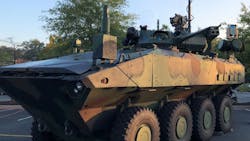QUANTICO, Va. – U.S. Marine Corps amphibious warfare experts are asking BAE Systems to design a high-firepower version of the Amphibious Combat Vehicle (ACV) armed with a 30-millimeter cannon under terms of a $27.8 million order announced Friday.
Officials of the Marine Corps Systems Command at Quantico Marine Base, Va., are asking the BAE Systems Platforms & Services segment in Sterling Heights, Mich., for phase-three design and development of the ACV medium caliber cannon mission role variant.
BAE Systems is the ACV prime contractor. The ACV is a wheeled armored combat vehicle able to move Marine infantry warfighters from ships offshore to fight their way onto invasion beaches.
BAE Systems reportedly has selected a version of the MCT-30 medium-caliber turret from Kongsberg Defence & Aerospace in Kongsberg, Norway, for the ACV version. The company reportedly will deliver as many as 150 of the MCT-30 remote turret weapon systems for the ACV.
Marine Corps leaders are considering three variants of the ACV — a command and control configuration, a recovery and maintenance vehicle, and a version with a 30-millimeter cannon. The MCT-30 turret selected for the ACV is a version of the 30-millimeter gun on the U.S. Army Stryker wheeled combat vehicle.
The 30-millimeter cannon can be effective against lightly armored vehicles, fortified bunkers, helicopters, and fixed-wing aircraft. 30-millimeter ammunition generally comes in three varieties: armor-piercing, high-explosive, and practice rounds. A 30-millimeter bullet is about one inch wide and six inches long.
The Marine Corps may buy as many as 204 ACVs over the next few years to outfit some of its 10 amphibious assault companies. BAE Systems bases its ACV design on the Superav 8x8 amphibious armored personnel carrier developed by the Italian company Iveco Defence Vehicles.
ACV systems are designed to operate through enemy direct fire, indirect fire, and land mines with low-profile visual and infrared signatures, modular protection, and other armored vehicle technologies.
Related: General Dynamics to equip Stryker combat vehicle with 30-millimeter cannon unmanned turret
The vehicles can swim to shore from as far as 12 miles out to sea, switch from operating in the water to ground operations without pause, and then maneuver with M1 Abrams main battle tanks in a mechanized task force. The ACV can destroy relatively light enemy combat vehicles similar to itself.
The ACV will provide direct fire support for Marine infantry, and can carry 17 Marines at speeds of at least eight knots at sea amid three-foot waves with waves as large as three feet.
On shore, the ACV has high-ground clearance and a V-shaped hull to resist the effects of land mine blasts, and can operate with a wheel blown off.
Each ACV has a crew of three, an M2 .50 caliber machine gun in a remote weapons station, with the potential to install a stabilized dual-mount M2/Mark 19 grenade launcher turret, and now can have the 30-millimeter cannon.
On this contract BAE Systems will do the work in San Jose, Calif.; York, Pa.; Kongsberg, Norway; Stafford, Va.; Bolzano, Italy, and Aiken, S.C., and should be finished by July 2022.
For more information contact BAE Systems Platforms & Services online at www.baesystems.com, or Marine Corps Systems Command at www.marcorsyscom.marines.mil.



